
a web page by Don Roberson |
LEAFBIRDS Chloropseidae |
|
Among the most attractive is Gold-fronted Leafbird (below) which can sometimes be found feeding on flowers. Leafbirds have spiked tongues adapted for taking nectar and often poke into tubular flowers. This is similar to the Rhabdornises of the Philippines, an endemic genus of starlings (Rhabdornis). Unlike Rhabdornises, leafbirds build cup-shaped nests. That character, plus their overall green plumage, their arboreal habits, and their whistled songs, sort-of remind me of North American vireos. Leafbirds are a bit larger and lankier than vireos, being about the size of Hooded Oriole Icterus cucullatus of North America. |
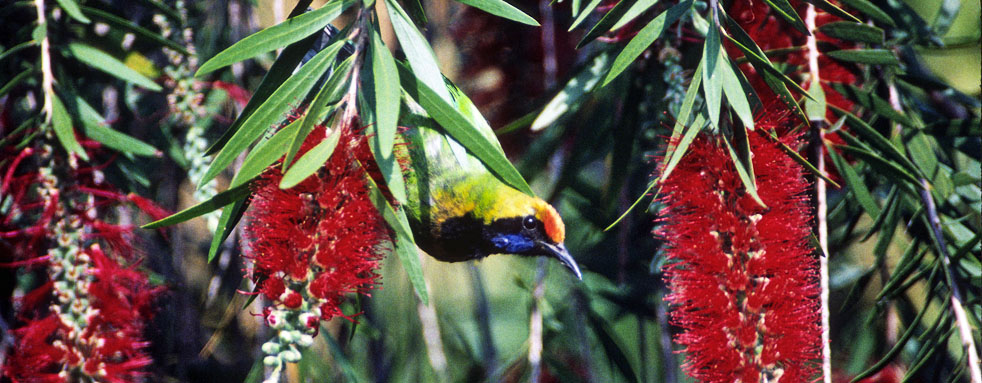 |
Leafbirds were traditionally considered closely related to the Ioras (Aegithinidae). Like ioras they tend to forage alone or in pairs in the subcanopy, often eating berries and fruit and well as insect prey. Some literature as recent as the turn of the century continued to place the leafbirds together with the ioras in the same family (e.g., Kennedy et al. 2000). Even the Handbook of Birds of the World series (Wells 2005), whose taxonomic layout had to be determined years before publication, placed leafbirds and ioras almost next to each other. However, by then, DNA studies (Sibley & Ahlquist 1990) showed that leafbirds were not closely related to ioras, but where they belonged did not become evident until the early 21st century. Molecular evidence (e.g., Beresford et al. 2005, Treplin et al. 2008) found that leafbirds were in the "passeroid radiation," and their nearest relatives were the fairy-bluebirds (Irenidae). Together, the closely-related leafbirds and fairy-bluebirds are perhaps closer to sunbirds (Nectariniidae) and flowerpeckers (Dicaeidae) than any other passerines (Johansson et al. 2008). This is very different than ioras, which proved to be in the "corvoid" radiation, and are now placed near bushshrikes, a long distance from the leafbirds in any taxonomic layout. |
Sadly, the trade in capturing and selling leafbirds has become the greatest threat to a number of species. Keeping colorful passerines in cages, especially if the species is a singer, is now a social status symbol in some Asian countries. The Malaysian, Singapore, and Indonesian avifaunas are under the greatest threats. Greater Green Leafbird (the first photo at top of this page) was widespread and common during my Asian visits in the 1980s–1990s. Now, that species is listed as Endangered. The endemic island species are also significantly reduced. As just one terrifying example, see Iqbal et al. (2020). A photo gallery of caged birds for sale, including a male and female Sumatran Leafbird C. media separately in tiny cages at a Sumatran market. This is a species I missed on my trip to Sumatra in the last century, and hopes of seeing one in the wild now are rapidly diminishing. |
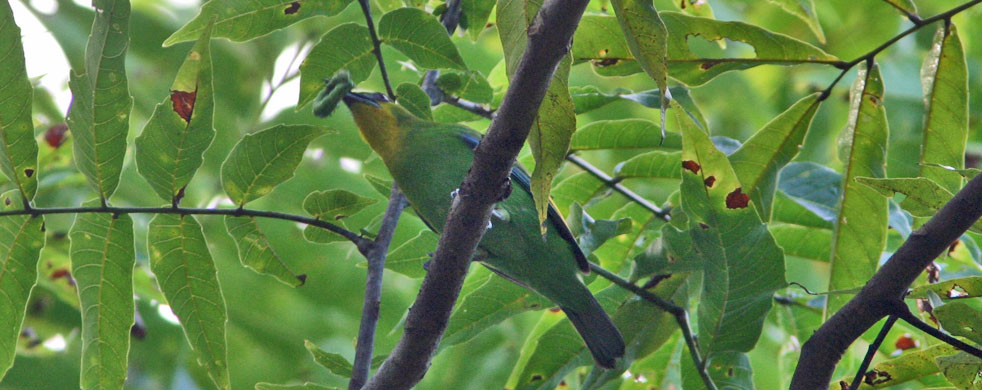 |
Photos: The Greater Green Leafbird Chloropsis sonnerati was at Gunung Panti Forest Reserve, Malaysia, on 24 Sep 2011. The male Gold-fronted Leafbird Chloropsis aurifrons was at the Quality Inn near Ramnagar, Uttar Pradesh, India, on 13 Mar 2001. The female Orange-bellied Leafbird Chloropsis hardwickii was at Deothang, Bhutan, on 17 Mar 2019. The first Yellow-throated Leafbird Chloropsis palawanensis was at Balsahan, Palawan, Philippines, on 21 Feb 1990; the second photo of Yellow-throated Leafbird was in Puerto Princessa Subterranean NP, Palawan, Philippines, on 14 Dec 2005. All photos © Don Roberson; all rights reserved. Bibliographic note: There is no "family book" per se, but a fine introduction to this family, with some good photos, is in Wells (2005). Literature cited:
|
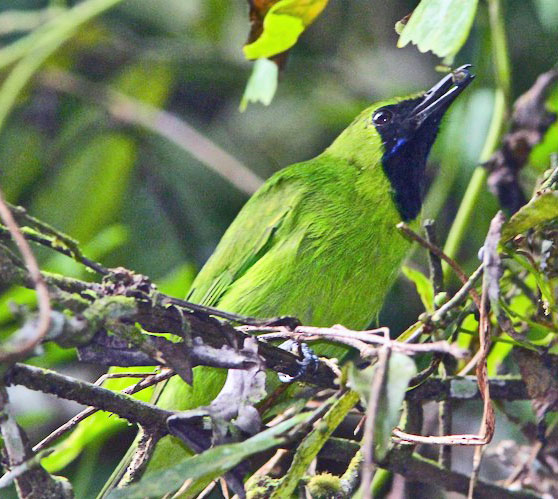 The Leafbirds are a small group of arboreal passerines found throughout tropical Asia. All are closely related in the same genus [Chloropsis]. Leafbirds tend to be various combinations of green, yellow, and sometimes a little blue, and often males (and sometimes both sexes) have conspicuous black masks. A good example is Greater Green Leafbird (left). Greater Green Leafbirds is among six species that occur widely in either India or southeast Asia/Greater Sundas; two each are endemic to Sumatra and the Philippines; and one is endemic to Borneo highlands. This is three more species than when I first posted a Leafbird family page in 1999: two additional species were carved from Blue-winged Leafbird C. cochinchinensis and one from Golden-fronted C. aurifrons (Wells 2005).
The Leafbirds are a small group of arboreal passerines found throughout tropical Asia. All are closely related in the same genus [Chloropsis]. Leafbirds tend to be various combinations of green, yellow, and sometimes a little blue, and often males (and sometimes both sexes) have conspicuous black masks. A good example is Greater Green Leafbird (left). Greater Green Leafbirds is among six species that occur widely in either India or southeast Asia/Greater Sundas; two each are endemic to Sumatra and the Philippines; and one is endemic to Borneo highlands. This is three more species than when I first posted a Leafbird family page in 1999: two additional species were carved from Blue-winged Leafbird C. cochinchinensis and one from Golden-fronted C. aurifrons (Wells 2005).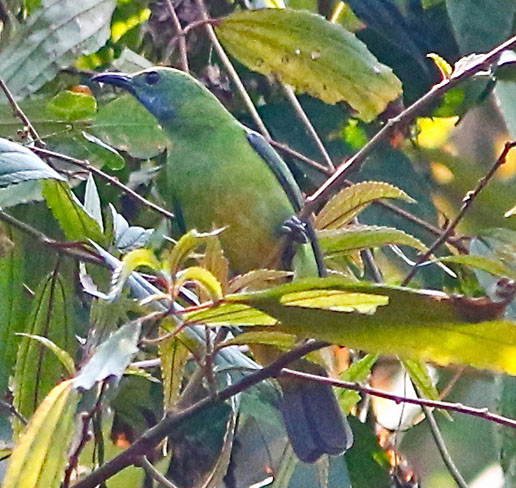 Leafbirds often occur in pairs, and for the most part they are sexually dimorphic. In the widespread species, males have black masks and females have plain faces. Orange-bellied Leafbird (right) occurs widely in foothill forests from the Indian Himalayas to south China, and through southeast Asia. Males are quite striking with a black mask, accented by bright blue "jawline" feathering, and a orangey belly. Females are plain-faced with a light blue wash to the malar area, and an orangey belly (this is a female; right). This photo does give one the impression that it can often be hard to spot a green bird in a green tree, especially if (like leafbirds) the behavior is slow and sluggish.
Leafbirds often occur in pairs, and for the most part they are sexually dimorphic. In the widespread species, males have black masks and females have plain faces. Orange-bellied Leafbird (right) occurs widely in foothill forests from the Indian Himalayas to south China, and through southeast Asia. Males are quite striking with a black mask, accented by bright blue "jawline" feathering, and a orangey belly. Females are plain-faced with a light blue wash to the malar area, and an orangey belly (this is a female; right). This photo does give one the impression that it can often be hard to spot a green bird in a green tree, especially if (like leafbirds) the behavior is slow and sluggish. 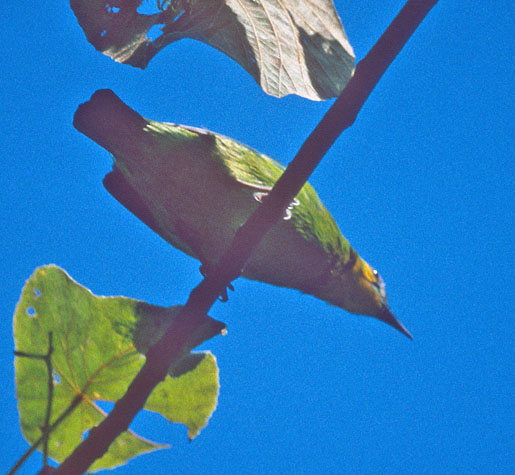 Five of the leafbirds are island endemics: two in the Philippines, one on Borneo, and two on Sumatra. There is also an island population of Blue-winged Leafbird C. cochinchinensis on Java that could be elevated to the species status in the future. This (left and below) is Yellow-throated Leafbird, endemic to the island of Palawan in the Philippines. It is a short-tailed leafbird, and in this species, the sexes look more or less alike (neither has a mask). In the photo below, you get the feeling of a green bird in a green tree catching a green caterpillar. "Leafbirds" is a pretty good name for this family.
Five of the leafbirds are island endemics: two in the Philippines, one on Borneo, and two on Sumatra. There is also an island population of Blue-winged Leafbird C. cochinchinensis on Java that could be elevated to the species status in the future. This (left and below) is Yellow-throated Leafbird, endemic to the island of Palawan in the Philippines. It is a short-tailed leafbird, and in this species, the sexes look more or less alike (neither has a mask). In the photo below, you get the feeling of a green bird in a green tree catching a green caterpillar. "Leafbirds" is a pretty good name for this family.